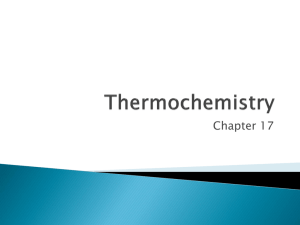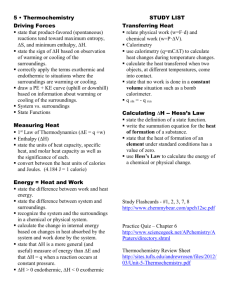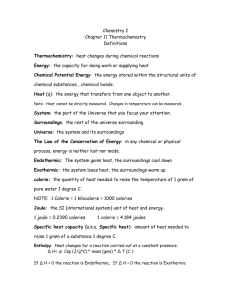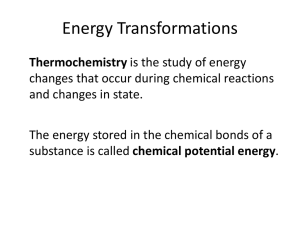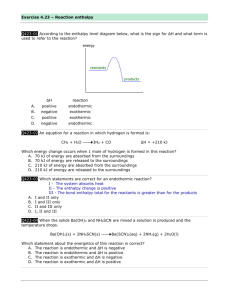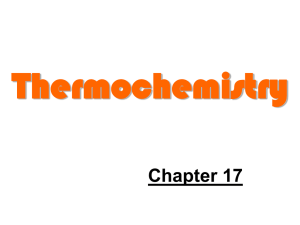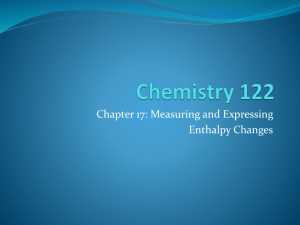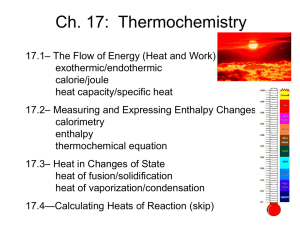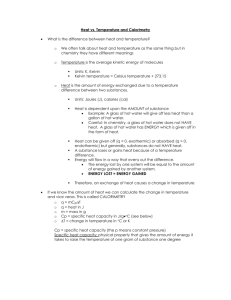Thermochemistry
advertisement
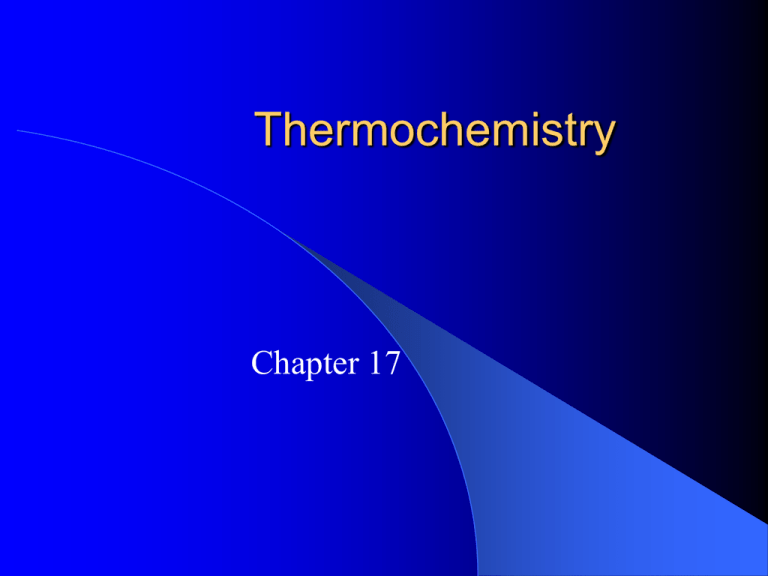
Thermochemistry Chapter 17 The Flow of Energy – Heat and Work Essential Question: What is heat, and how is heat involved in endothermic and exothermic reactions? Energy Transformations Energy is the capacity to do work or supply heat. Energy does not have mass or volume. Energy is detected only because of its effects. Thermochemistry Thermochemistry is the study of energy changes in chemical reactions and in changes of state. All substances have energy stored in the chemical bonds that hold the atoms together. This energy is called chemical potential energy. Heat ( q ) Heat is energy that transfers from one object to another because of a temperature difference. Heat always flows from a warmer object to a colder object. This continues until the objects are the same temperature. Conservation of Energy System – the focus of attention Surroundings – everything else Law of Conservation of Energy – in any chemical or physical process, energy is neither created nor destroyed. Endothermic and Exothermic Processes Endothermic Process – energy is absorbed from the surroundings. The system gains heat as the surroundings cool down. Exothermic Process – energy is released into the surroundings. The system loses heat as the surroundings heat up. Units for Measuring Heat Two common units – calories and joules. Calorie = the amount of energy needed to raise the temperature of one gram of pure water by one degree Celsius. 1 Calorie = 1 kilocalorie = 1000 calories 1 Joule = 0.2390 cal or 4.184 Joules = 1 cal Heat Capacity and Specific Heat Heat Capacity = heat needed to raise the temperature of an object by 1 °C Specific Heat (Capacity) = heat needed to raise the temperature of one gram of a substance by 1 °C. Water has high specific heat; metals have low specific heat. Q = m c ΔT Heat is equal to mass times specific heat times the change in temperature. Caution! Filling Is Hot!! Don’t lick the flag pole during the winter!! Measuring and Expressing Enthalpy Changes Essential Question: How do chemical equations express heat changes, and what law is made use of in calorimetry? Calorimetry The heat released by the system is equal to the heat absorbed by the surroundings. The insulated device used to measure this is called a calorimeter. The change in heat content is called a change in enthalpy. Heat = enthalpy change ( q = ΔH ) Calorimetry Heat absorbed by the surroundings is equal to the heat lost by the system: qsys = ΔH = −qsurr = −m × C × ΔT Thermochemical Equations In a chemical equation, heat can be written as either a reactant or as a product. Exothermic Reactions The heat released is written as a product: CaO(s) + H2O(l) → Ca(OH)2(s) + 65.2 kJ The change in enthalpy is a negative value: CaO(s) + H2O(l) → Ca(OH)2(s) ΔH = −65.2 kJ Endothermic Reactions The heat absorbed is written as a reactant: 2NaHCO3(s) + 129 kJ → Na2CO3(s) + H2O(g) + CO2(g) The change in enthalpy is a positive value: 2NaHCO3(s) → Na2CO3(s) + H2O(g) + CO2(g) ΔH = 129 kJ Heat of Combustion …is the heat of reaction for the complete burning of one mole of a substance. CH4(g) + 2O2(g) → CO2(g) + 2H2O(l) + 890 kJ CH4(g) + 2O2(g) → CO2(g) + 2H2O(l) ΔH −890 kJ Heat in Changes of State Essential Question: How does the quantity of heat absorbed by a melting solid compare to the heat released in solidification? and how does the heat absorbed by a vaporizing liquid compare with the heat released when the vapor condenses? Heats of Fusion and Solidification Heat absorbed by one mole of a solid as it melts = molar heat of fusion Heat lost when one mole of a liquid solidifies = molar heat of solidification For a given substance: Δ Hfus = Δ Hsolid Heats of Vaporization and Condensation Heat necessary to vaporize one mole of a liquid = molar heat of vaporization Heat released when one mole of a vapor condenses = molar heat of condensation For a given substance: Δ Hvap = Δ Hcond Heat of Solution During the formation of a solution, heat is either released or absorbed.
